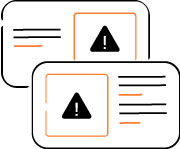The center of attention of IT industries has shifted from serving the crowd with benefits like cost reduction, better efficiency and improved productivity to initiating new engrossing opportunities for the businesses, and business automation does all of it.
As per Statista, Automation Industry is anticipated to generate around 214 billion U.S. dollars worldwide by 2021. Also, another study reveals that by 2025, over 90% of businesses will shake hands with automation, up from less than 20% as recorded in recent times. Nonetheless, this proclaims that businesses are trusting and embracing the idea of Business process automation and the future doesn’t seem to be any different, too.
Since the numbers stand firm by the potential of business process automation, it becomes evident that automation goes beyond typical and oldfangled methods of workflow management and rather it helps companies to take control over a number of issues related to analytics, sales, standardization, planning, development etc. allowing organizations to focus more on their core tasks.
What is business process automation?
Precisely, business process automation is a procedure where businesses leverage technology to automate processes and perform tasks to accomplish their goals, improve operational efficiency, enhance productivity and improve standardization. BPA aims to identify the heavily manual effort-consuming processes across all departments and then remodel their execution for overall profitability.
When to choose business process automation
By now, you have a fair idea regarding how business automation works from the previous discussion. Now the question is, when to opt for business automation? Though the scope is virtually unlimited, but here are some very prominent indicators to look for

Is your business having a tough time balancing deadlines and operational costs?
No matter what industry your business is associated with, the tug-of-war between meeting tight deadlines and controlling increasing operational costs become a constant struggle. Since you need to speed up each of the business activities to ensure on-time delivery, you require to engage more manpower and thus, operational costs soar higher. As a result, there is a gap between both time and cost management and manual efforts can do very little to bridge that!

Have human errors become an inevitable part of your business processes?
Engagement of more manpower invariably leaves increased space for human errors. The obvious result is that the quality of service highly deteriorates.
Is it becoming increasingly difficult to monitor the activity trail?
Your business process probably includes too many interlinked steps right from managing orders to completing delivery, and chances are there, you are yet to implement a definitive tracking process to monitor each of such activities. That is exactly what impedes the quality control phase in your routined business process.

Lacking effective insights to streamline decision-making?
No one can deny the importance of well-calculated business analytics providing detailed insights, but most of the businesses make do without it because of the complexity to generate such analytics! As a result, the business decisions made without considering real-time analytics miss out on effectiveness to a great extent.

Can not get rid of errors when it comes to record keeping of your various business processes?
Record Keeping is one of the most burdensome parts of a business and when voluminous business data is handled manually, mismanagement and wrong entries become unavoidable. Such faulty management does not just harm the particular record, but also takes a toll on the entire workflow and eventually leads to errors and faults.
Above are some of the high level barriers almost every business encounters within their day-to-day operations and business process automation can very well be the one-stop solution. If your business struggles with some of the similar issues, now is the right time to go for business process automation!
Know the Essential Components of Business Process Automation
BPA may be a simple word to hear but it’s an amalgamation of multiple modules united by one common goal – to add speed & efficiency to the business processes. Let’s have a closer look at the core components of business process automation!

Business Intelligence Infusion
Business process automation makes way for more informed decisions through pre-historic data analysis – thanks to business intelligence. BI driven decisions usually scan across a defined workflow to closely monitor the business operations & simultaneously record crucial business data. For instance, companies can establish workflows that execute functions like assigning a task to someone or saving a document to a specific folder in a document management system.

Real-time Analytics
Real-time data processing is an integral part of every business and having insights extracted off that is the recipe to its success. BPA aims to unify the critical data collected across the business processes & visualize them for better decision making. So a well built analytics & reporting module makes the growth path easy while ensuring informed decision making.

Flexible Data Access
Enterprises have multiple hierarchies & users in each level have varied needs to access & process the data. An effective approach towards BPA should ideally take into account a centralized data repository with varied access control imposed. That way, everyone gets access to the updated data while only the concerned people can make changes.
Benefits of Business Process Automation
Apart from optimizing your ongoing workflow, business process automation, also termed as BPA, can also bring in increased efficiency, and add to current profits. By now you already know that automating your business processes will improve your information management, process handling, and increase overall productivity.
That’s about what it does. Now, let’s get into how BPA is beneficial for your business and figure out the reasons that make it worthwhile, even though the initial cost you need to pay for automating your processes is on the higher side.

Eliminate manual work and save time
Let’s say, you are running a shipping business and you have several trucks who are involved in your business. You take orders through emails or phone calls, then contact your trucks for their availability, location etc. and then assign the shipping order to the available truck.
Now instead of these huge manual labour if you automate your business workflow and build an automated shipping software, you can manage your trucks, see their availability, current location, their next engagement etc. from a single platform. And based on these criteria your software will automatically assign the truck.
This automation will not only eliminate your manual labour it will also help you to reduce time which you can spend to increase your business and profits.
Eliminate unnecessary / repeated task and reduce cost
The more you can save man-hours, the more you can save money. Right?
If you are in a home repairing business where you have several field agents and technicians who visit each of your customer’s homes, investigate their problems, fill up mandatory information, take notes, then work on those issues and you are paying those agents or technicians on an hourly basis. Now think, how much extra time it is taking your technicians to manually work on those information gathering, investigation etc. which is ultimately knocking at your account.
With a business process automation software, if you allow your customers to explain their problems, provide required information, initiate dynamic conversation etc. through an online form, So technicians no longer have to manually ask those questions again , even they will have those information beforehand. Also based on that customer’s information, you can assign the best suitable technicians who can visit the customer’s home and directly jump into their work.
Business automation will help you to eliminate manual repetitive tasks and save man hours which will ultimately save your money.


Monitor employee’s timeline and assign work accordingly
With reference to the previous example, if you can see your employee’s specializations, availability, engagement etc. in real time, you can focus on strategic and innovative initiatives to assign the right project to the best suitable employee based on the required specialization and other parameters.
No matter whatever business you are in, every business has it’s own business goals and own way of implementing business process automation. When you can clearly visualize your employee’s work or their engagement, you can make better decisions to prioritize your work and allocate best suitable employees.
Human error is a reason of unproductiveness
It is obvious that whenmanual errors will be less, the productivity will be automatically increased. And no matter how efficient your employees are, it’s quite impossible to avoid manual errors.
There are so many businesses who are running manual processes for their day to day work. Starting from the very basic task, like copy/pasting, emails, to crucial invoicing, a single error could hold your business back, hence your business will lose productivity! With the help of business process automation software, you can automate most of your business processes which will ensure error free work.


Communication is the key to productive and qualitative work
If you have a marketing team for your business, your team is definitely required to communicate with each other to execute a successful marketing strategy. You also want to have an insight of that strategy, right? So that you can make sure your team is going in the right direction and you can give your input if required. Don’t you think it’s an overhead to manually handle and track the collaboration process of the entire team.
With an automated collaboration software(Like Project Management Module, Sales Pipeline Management Module etc.), not only your employees could have seamless collaboration, it will also help you to keep a track of the changes or input made by the specific team members. It will give you the ultimate qualitative result for your marketing effort.
Whenever a specific task / project requires multiple employee involvement, with an automation software you can allow your employees to collaborate seamlessly with each other and complete a task efficiently.
Ensure availability and increase reliability to your customer
Let’s say you are in a telecom business, where you have to deal with a large number of customer base. Now if you have to manually address these numerous customer’s problems, you need to have a huge team of customer care executives which is extremely expensive. An automated chatbot within your telecommunication software, can easily solve your customer’s basic problems and whenever there will be some tricky or complex problems which require human interaction, the system can seamlessly transfer the call to the executives.
Also a remote mobile module within your business process automation software, will allow your employees to be available from any location and any time and attend to your customer’s requirements which will increase your employees’ availability and company’s reliability.


Right message at the right time increase customer’s satisfaction
Customer’s satisfaction is the ultimate goal of any kind of business, right? If you just started a business with a small customer base you can keep a track of each of your customers and their requirements manually. But once your business grows with a large number of customers, you won’t be able to manually handle all of your customer’s interaction and give them the best service with timely follow up, customized offers etc.
If you have a CRM module as part of your business management software, you will have a 360 degree view of your customer interactions, problems and more importantly their needs and accordingly give them the best service by automating the follow up process, personalized offers, tailored solutions etc.
Focus on core business process and increase ROI
In your business, when you handle so many diverse processes manually, it is difficult to understand which processes are really driving your business and which have become more of a burden to your business. Also retaining competitive advantage requires constant monitoring and modifying business processes and strategies.
But business process automation will help you to collect insightful data points, which will give you a clear idea about which processes are giving your business the maximum ROI and which are just consuming your critical business resources without giving any significant return. And from these data driven insights, you can make informed decisions on which business processes need to be improved by automation, or which process could be outsourced and which could be eliminated all together.
Also it will help you to make better use of your time and resources to find exciting new opportunities and strategies to take your business to the next level.

Why choose custom software solutions over OTS?
Now that you’re well aware of the value that a business process automation software will add to the bottomline of your business, you have two choices. You can either pick an off-the-shelf (OTS) solution making rounds in the market, or opt for custom software development. Here comes back the perennial question, what would be a smarter investment? Whether to buy or build?
This is an ever-haunting question to the enterprises looking for software solutions to embrace the digital enhancements. For off-the-shelf software solutions you are required to evaluate and compare from a slew of available solutions and select the one which is closest to your specific business requirement (also, I wish you a bit of luck also here!), on the other hand, the custom software solutions are developed right from the scratch based on the specific problems you are looking to solve and the features & functionalities you want to incorporate.
While both the OTS and custom solution are capable of solving your problem, the extent to which they do so is the real deal! There is a wide gap between OTS and custom business automation software solutions in terms of performance, effectiveness and usability.
Let’s weigh the fundamentals of OTS and custom business automation software to figure out which one fits your needs the best!
Cost
At the first look, an off-the-shelf solution will be cheaper as compared to a custom developed solution, because the cost associated with an OTS is shared among a community of businesses purchasing that same software, and so, the pricing gets distributed across a number of licenses to be given out.
Whereas, a custom-made solution is particularly developed for you, and thus, the entire development expenses need to be borne by you. Even though custom development initially comes off as pricey, the cost is for more than just the initial design, as the building, testing and implementation fees are also included in it. Thus, with this one-time investment you get (i)the lifetime usage rights for that software, (ii)up or downsizing the software based on your user-count as per project scope, (iii)general maintenance etc. which implies improved ROI overweighting that of an OTS.


Customization
As the name itself suggests, customization plays the trump card that a custom software solution holds and the OTS lacks, big time. The truth is, no two businesses are absolute identicals, so can’t be their problems. When you opt for a custom built software, you get a compact solution to all your unique business challenges at once, as it contains solely custom features synchronized with your unique workflow.
Whereas, an OTS solves a common set of problems faced by the majority of its users only, without prioritising your specific requirements. Thus, to make an OTS solution work for you, you need to adjust your ever practiced workflow according to what a mass of businesses prefer to follow. While that sounds like a little sacrifice in the beginning, within months or even weeks of using the OTS when the requirement of new features and functionalities come up, the only way you can get your work going is by purchasing additional softwares and running all of those parallely. Multiple softwares doesn’t just make the process complicated, but also exceeds your budget altogether.
Integration
In today’s date where analytical insights significantly add up to competitive advantage, an ideal software solution should seamlessly integrate with the third party softwares which your business has been using for so long. To carry out critical business processes efficiently, easy access to data without jumping through the hoops of data silos is a mandate. That is where the additional time and money invested in custom software development bear its fruit, as it deploys seamless integration with existing softwares that your employees are familiar with.
But, an OTS solution doesn’t consider any such specific integration as it caters to several other users, all of whom are possibly used to working with varied third party softwares. Thus, unlike a custom solution, an OTS is unable to sit in your existing IT ecosystem and integrate smoothly and eventually create a lot of those forbidden “Data Silos”.


Security
When it comes to an OTS software solution, any business can purchase the software just like you, which can cause significant threat to your confidential business information in terms of cybersecurity. Being easy to access, an off the shelf software enables malicious cyber criminals to break into the system and access the corresponding details before planning an attack.
On the other hand, with a custom developed software, there’s a stronger layer of security as no one but you has the right to access the software.
Scalability
Scalability has a direct impact on your business growth, as when you grow your business, your clientele expands and simultaneously, your software infrastructure demands to be scaled up, too. If you get a custom developed software designed by the right custom development company, you will have immediate resources available to size the solution to fit your increased requirements.
With an OTS software scaling up a desired portion of the software is not as easy. The obvious reason is that an OTS serves a common purpose for several businesses at once and not all of those businesses have the same needs in terms of scalability. As a result, an OTS ends up blocking your path of growth.

BinaryFolks BPA Use Cases Across Industries
Business automation software development sure is a contemporary power weapon, provided it’s planned around a business’s core goals. While you can start with glancing through the top industry use cases, you can also directly schedule a meeting with the BinaryFolks BPA consultation team for more streamlined planning & discussion.
P.S. – The first round of consultation comes for free!
Fintech
Banking and fintech industries have gotten a new horizon of opportunities opened with BPA making an entry in the sector. Here’s a list of key use-cases of BPA automating:
- 1.Know Your Customer (KYC)
- 2.Redundant back-office tasks like customer application check & sort, data verification, form fill-up, account reconciliation, updating customer info etc.
- 3.Transactional risk prediction & compliance check
- 4.Credit score calculation & credit card request processing
- 5.Mortgage loan application processing & document verification
- 6.Suspicious transaction identification


Ecommerce & Retail
The ecommerce & retail sector deals with a lot of people & data alike and automation helps your business achieve the highest precision & productivity (thus, profitability!). Here goes the significant use-cases to be automated:
- 1.Invoice generation
- 2.Purchase behavior analytics
- 3.Inventory management & update
- 4.Product categorization & sorting
- 5.Demand & supply prediction
- 6.Customer service & grievance management
Manufacturing & Facilities
Manufacturing is the heart of production businesses and automation has transformed it for better. Quick look at the use-cases:
- 1.Supply chain optimization
- 2.Data management
- 3.End-to-end order fulfillment
- 4.Custom report generation on stock, freight updates etc


Real Estate
Automation made ‘expectations’ turn to ‘reality’ for the real estate industries and here’s a sneak peak of how!
- 1.Tenant onboarding
- 2.Rent Reminders
- 3.Listing & portfolio management
- 4.Net Asset Value (NAV) Calculations
- 5.Property Viewing
- 6.Multi-tenancy & agreement management
Transportation & Logistics
Automation has made the transportation & logistics industry steer clear off the time & operational cost issues by minimizing manual effort involvement & maximizing transparency across the end-to-end business workflow. Here’s a list of significant use cases:
- 1.Scheduling shipment and monitoring the tracking info
- 2.Freight allocation by drivers’ availability checking
- 3.Empty miles tracking & optimization
- 4.Procurement and inventory management
- 5.Speed consistency tracking
- 6.Order trend analysis


Media & Entertainment
Media today has high reliance on automation and if you are one from this industry looking to give automation a try, take a look at the use cases!
- 1.Enabling faster mobile / handheld device activation
- 2.Customer management through instant support on frequently faced challenges / queries
- 3.24*7 customer service request processing
- 4.Auto updation of metadata to present state-of-the-art, accurate data to the audiences in-line with ever-evolving user preferences
- 5.Personalized recommendation to users based on precious consumption history
Steps to implement Business Process Automation
Business process automation is not an overnight process, and it means you need to invest more than just money for foolproof business automation software development. Before adopting a software to automate processes effectively, first you need to research thoroughly and ideate the software followed by comparing it against your needs and evaluating how it can help you achieve your core business goals. Once you have thought through what enhancements you are looking for by deploying business process automation, you are good to go!

Identify The Tasks to Be Automated
To get your business processes automated, you must first make a list of all the processes you are looking to automate. Ideally, the list should contain processes associated with your business which-
- are inherently repetitive in nature
- require heavy manual effort
- are time-sensitive
- involve compliance as well as audit tracking
- highly influence other processes
Approach a software development company having proven expertise in business process automation for implementation
Once you have your requirements ready at hand, get in touch with the right software development company and discuss your requirements with the team. Finally, make sure you only sign up for a business process automation software which is-
- flexible and scalable, keeping the future requirements in mind
- efficiently integrates with your existing tech stack
- designed in accordance with the convenience of your workmen


Integrate with your existing IT set-up
After the business process automation has been implemented, the next step is to carry out an API integration to enable interaction between your existing IT ecosystem and the new software. However, if you opt for custom software development, you skip this hassle as the development company does it for you already.
Maintenance and Support
The process doesn’t cease with deployment and integration. Last but not the least, the maintenance phase, often termed as support, plays a pivotal role in business process automation in order to ease bottlenecks in the processes, if any. All sorts of updates, modifications, bug fixes, patches etc. to increase the performance and efficiency of the software comes under software maintenance.

Sectors suitable for Business Process Automation
Being industry-agnostic, business process automation is sure to upgrade all types of businesses, just at different extents. Think of the “Sorry for the inconvenience caused” email upon delayed shipping, or the birthday gift in the form of a coupon from the frequently visited restaurant, think of the “Hurry! Your favorite product is running out” reminder based on your wishlist at an online shopping site- each one is driven by automation of business processes. Here are a few common areas where a business automation software can bring in significant improvements-
Hiring and New Employee Onboarding
Hiring is not a single-step procedure as it requires accepting applications, shortlisting the suitable candidates, conducting interviews and finally sending out offer letters to the selected. The hassle doesn’t really end there, as the following activity i.e. onboarding new employees is another crucial part of every business. When these processes are automated, such repetitive tasks become easier with the system organizing received applications & sorting the submitted resumes based on an array of pre-fed keywords in order to select the appropriate candidates, taking care of orientation procedure by enabling training sessions, receiving verification documents and scheduling meetings.
Operation Management
Since operation management includes several dynamic activities like resource management, quality control etc., it gets difficult to monitor all those just with manual effort. As business process automation takes over, tracking and recording all the resources in use as well as the day-to-day business activities being performed, explicit outcomes are ensured with higher transparency.
Customer Support
Answering each and every customer support ticket is not just time-taking, but it also adds up to significant exhaustion, curbing productivity. This becomes evident especially when a major bug occurs, for instance. It becomes worse for your personnel to timely attend all the requests even though the answer for each would be exactly the same.
With business process automation, all such customer queries can be handled in no time by setting standard replies for frequent enquiries along with the mostly used words or phrases as the key identification factor, that is automatically sent to the customers.
For a business which knows its customer base well, identifying the problems is not much of a task. Thus, adding value to the bottomline of the business gets a lot easier with a reasonable process automation software replacing manual customer support.
Social Media Management
Social media management is such a marketing activity which can either click or not, i.e. you need to follow a trial and error approach investing humongous man hours even though the returns are highly uncertain.
Automating business processes can schedule campaigns and posts in advance, record responses received through all of your social accounts and generate periodic reports and regular updates saving you a great deal of time while serving the purpose.
Communication and Collaboration
There’s one thing constant in every business and that is internal communication with the employees. Thus, communication holds immense importance, yet the old school communication process fails to do full justice to its potential. However, business process automation ensures minimizing the need of frequent meetings by speeding up the feedback exchange process as well as sharing critical business data without human intervention.
Record Keeping
Manually keeping records of every activity related to a business often leaves ample scope of mismanagement and wrong entries. Maintaining huge spreadsheets are no exception. On the other hand, by automating the record process, making multiple entries in several data reports, copying and pasting data from one spreadsheet to another, or reformatting & modifying some part of a document becomes quicker and hassle-free.
Business Data Collection
Business processes require gathering relevant data for checking feasibility of a business product, comparing a product with another etc. If handled manually, this task often takes a lot of time and fails to fetch a good volume of data even after putting in enormous manual effort. But, business process automation grabs accurate information fast and with improved efficiency, helping you make a factual and strategic decision rather than going by your gut feelings.
Invoice Processing
Gone are the days of processing manual invoices one after another, paying scrupulous attention and hours from your valuable time. As automation steps in the scenario, the system effectively captures the invoices from the source (e.g. – fax, email, document etc.) itself, extracts useful information and after processing, routes the financial data in a format compatible with your existing system to the accounts department for approval and transaction.
Email Management
Email being the core of both internal and external business communication, holds utmost significance. But, handling emails with manual effort has high chances of losing track once the trail goes on for a longer period and hence leads to crucial data being lost. As you automate your email management process, it doesn’t just save you a lot of time, but also makes the entire process more efficient, ensuring no important mails go unchecked and with automated replies & follow-ups, capturing clients is made a breeze, too.
Employee Analytics Automation
The human resources department in every business needs to analyze the performance of its employees from time to time in order to maintain quality of service. With a set of other aspects to take care of, it often becomes burdensome for HR managers to manually look into performance of all considering every bit of the work they have done. Tracking employee activities through automation ensures accurate analytics based on real-time data, tracking every task performed by each employee along with generation of precise and crisp reports.
Client Success Stories
FAQs
Every business process cannot and should not be automated. Businesses need to decide which all processes can be automated and which all can be handed by humans more efficiently.
Repetitive tasks, tracking, alerts, manual calculative processes, documentation and its management, support services etc are some of the processes that can be automated to produce great results.
The first and foremost thing to do is plan and document all the processes in your existing system that you want to be automated. After you have jotted everything down, search for a business automation software development company that can help you with the development.
Discuss all the requirements with them and they will help you understand how they can help you automate business workflow. When everything is discussed and settled, there you are, ready to go!
If your requirements are limited then the cost incurred will also be less. Adding more features to your business process automation software will take the cost to the higher side.
Read more: How much does it cost to make an app?
Complexity of software, the features and functionalities, number of workflows you want to automate, integrations, etc are a few factors that are considered before deciding the overall time taken for a complete implementation.
Read more: How to estimate software development time?













